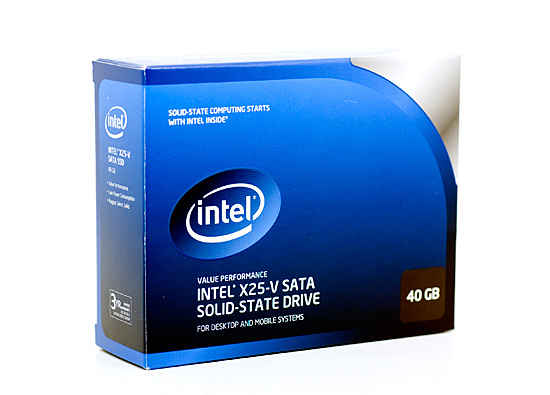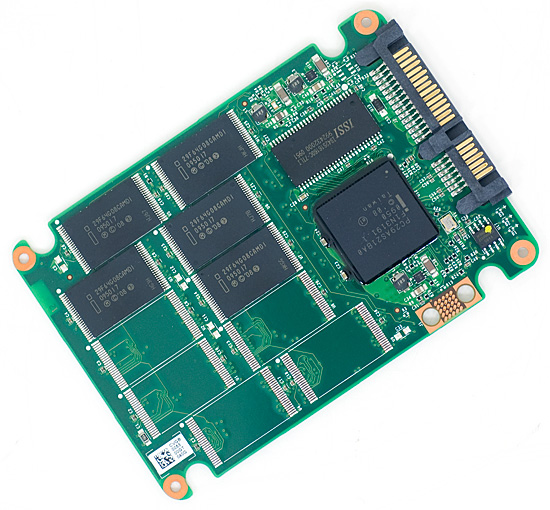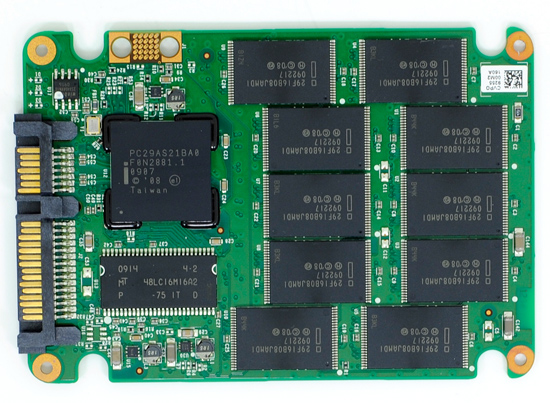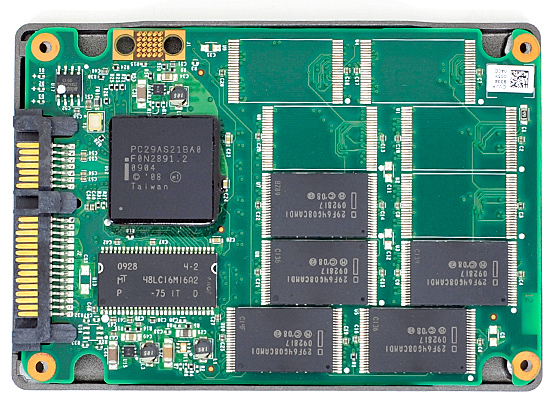Intel's X25-V & Kingston's 30GB SSDNow V Series: Battle of the $125 SSDs
by Anand Lal Shimpi on March 19, 2010 12:00 AM EST- Posted in
- Storage
V for Vende...Value
This is the first time I’ve actually received a retail boxed Intel SSD. The packaging actually mimics that of Intel’s boxed CPUs:

Inside the retail package you’ll find a full upgrade kit. You get a 3.5” mounting plate, a mini CD with an installation guide on it, one of those My SSD Rocks! stickers and the drive itself.

The X25-V ships in the same aluminum housing as the X25-M G2. Cracking it open reveals a bare side of the PCB:

Flipping it over we see the 5 x 8GB 34nm IMFT flash modules, the G2 controller and 32MB of PC133 SDRAM. The controller and SDRAM size/speed are identical to the 80 and 160GB G2s we reviewed last year.

Intel's X25-V PCB
With only half the channels populated, sequential write speed is about half of the X25-M G2 (~40MB/s vs. ~80MB/s). Remember that Intel’s controller uses free space as spare area, so with potentially less free space on the drive the 40GB X25-V will undoubtedly perform much worse than the 80GB or 160GB X25-Ms.

Intel's X25-M G2 PCB
In practice, the X25-V should perform very much like last year’s 40GB Kingston V Series Boot Drive. The two are identical minus official support for TRIM in the X25-V’s firmware.

Kingston's 40GB V Series Boot Drive PCB
Intel’s storage drivers (Intel RST 9.6) with TRIM support are expected to be available any day now so you’ll no longer have to rely on Microsoft’s AHCI drivers for TRIM.










78 Comments
View All Comments
AnnonymousCoward - Monday, March 22, 2010 - link
410GB for apps, are you insane? The only way I can see that possible is if you store every warez app out there.Even my bloated work machine only uses 21.3GB.
davepermen - Saturday, March 20, 2010 - link
tell that to our work systems which have all sort of apps on + os (+office, sap, and many other things) and all have only a c:\ drive.it's perfectly doable. not for everyone (esp. not for gamers), but for more than people might imagine.
iwodo - Friday, March 19, 2010 - link
While the idea of $125 for 80GB Intel SSD is nice, but if we dont get any performance improvement over current Gen then market might wait again.SATA 3?
ONFi 2.0 / 2.2?
Faster Random Read / Write?
I really hope we get new Intel SSD controller.
Japunie - Friday, March 19, 2010 - link
I'd like to see some benchmarks showing time saved. That's my main issue with a benchmark. Most show a higher number, but don't exactly show yo uhow much time your saving.Gaming benchmarks are self-explanatory but I would love to see more benchmarks showing the time difference as that to me is the ultimate reason to upgrade not just to have the fastest card, what have you.
semo - Sunday, March 21, 2010 - link
i'm for more real world testing. fot consumer sata drives stuff like startup times and virus scans. for eneterprise sas drives i want to see exchange, sql, etc performance numbers.AnnonymousCoward - Saturday, March 20, 2010 - link
You're absolutely correct. I've posted this 3 times and emailed Anand directly, but he continues to ignore it.http://tinyurl.com/yjcr5vm">http://tinyurl.com/yjcr5vm
http://tinyurl.com/ylflfao">http://tinyurl.com/ylflfao
There's no question that he's dead wrong to not address the single thing that matters with hard drives: time. Without it you can't see how significant the difference between drives are, the AnandTech Storage Bench doesn't mean squat since drives like the SandForce use compression, and hard drives have a long history of performing differently in benchmarks vs real life. For proof of those last two points, check out http://tinyurl.com/yamfwmg">http://tinyurl.com/yamfwmg where RAID0 bought 20-40% more IOPS but zero load time.
The only SSD time benchmarks I know of here are Pages 29 and 30 of the very first review http://tinyurl.com/yd73sf8">http://tinyurl.com/yd73sf8. Whuddayaknow, the Vertex boots up 1.2s slower than the X25-M, and loads WoW realms 1.4s slower. How about that, something tangible and meaningful to compare.
Belard - Friday, March 19, 2010 - link
Don't they usually?The kinds of numbers that are easy to understand:
- Win7 boot time (after POST is preferred, but whatever)
- Loading of a game, loading of a game while doing a background task.
- virus scan
- Loading and saving a large file in Photoshop or Excel.
- Win7 Shutdown time.
- Win7 Wake up (perhaps to quick).
My own experience with Win7 and the intel X25-M-G2
Win7 boot:
1m25s = Temp 160GB HD SATA (not a fast drive)
0m09s = Intel SSD (same computer)
0m35s = Another PC with a typical 500GB 7200RPM drive.
Belard - Friday, March 19, 2010 - link
All the Sandforce drives are near the top, in general.But I'm not really seeing those drives out in the market? What are those prices like.
I have my experience with intels X25 G2 drives and they still seems to offer the best overall deal. Reliability, TRIM and price (now). The 80GB G2 is down to around $200... so spend an extra $80 and double the space to work with and vastly improve the performance over any of those drives.
A typical Win7 setup with NO user data is about 15GB, which mine is with various Adobe programs, 3 browsers, Office suite and dozens of add-ons. So a 30GB is barely enough for future usage. 40GB is fine, but the performance needs to be better IMHO in order for it to be an excellent desktop boot drive. In one of our desktops in an office, Win7 boots up about 8~10 seconds after POST. Everything is instant.
Scalptrash - Friday, March 19, 2010 - link
Less expensive, better specs. Hmmm...Ijiwaru - Friday, March 19, 2010 - link
newegg lists the 30GB at 89.99 standalone and 114.99(84.99 after MIR) for the kit.buy has the kit at 78.95 after MIR
amazon has the kit at 111.11